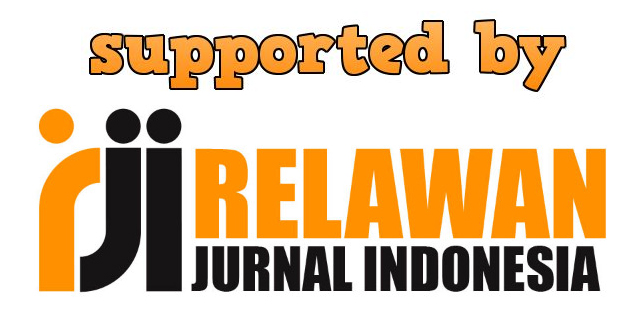Penggunaan Social Network Site (SNS) Instagram Sebagai Media Pemasaran Geriliya Digital
Abstract
Di tengah era globalisasi, penetrasi internet telah perlaham mengubah perilaku manusia dalam beraktivitas sehari-hari. Namun disaat bersamaan juga menghadirkan potensi dan inovasi yang dapat dilakukan untuk memudahkan manusia mencapai tujuannya. Kehadiran situs jejaring sosial dengan cepat menjadi media yang sangat digemari. Kemampuan situs jejaring sosial untuk menjangkau khalayak yang tidak terbatas kondisi geografi dan ekonomi dapat menjadi sebuah media baru yang dapat digunakan praktisi pemasaran dan periklanan dalam menyebarkan pesan mereka. Situs jejaring sosial yang populer di kalangan pengguna dan pelaku bisnis saat ini adalah Instagram. Dengan memahami karakteristik dan cara kerja Instagram, pemasar dapat membuat strategi yang efektif untuk menarik perhatian calon konsumen. Salah satu strategi yang dapat diterapkan adalah pemasaran gerilya digital. Walaupun strategi ini sebelumnya dilakukan secara analog, namun tetap memungkinkan untuk digunakan di dunia digital. Kajian ini menggunakan teknik wawancara dan observasi. Hasil kajian ini memperlihatkan bahwa dalam melakukan pemasaran geriliya digital, terdapat aspek-aspek yang perlu diperhatikan, yaitu fitur Instagram, alat bantu, hingga waktu penerapannya..
Keywords
Full Text:
PDFReferences
Boyd, D. M., & Ellison, N. B. (2007). Social network sites: Definition, history, and scholarship. Journal of Computer-Mediated Communication, 13(1), 210–230. https://doi.org/10.1111/j.1083-6101.2007.00393.x
Daer, A. R., Hoffman, R. F., & Goodman, S. (2015). Rhetorical functions of hashtag forms across social media applications. Communication Design Quarterly Review, 3(1), 12–16. https://doi.org/10.1145/2721882.2721884
Egan, J. (2007). Marketing Communication. London: Thomson.
Fichnova, K., Wokciechowski, L. P., & Mikulas, P. (2018). Trust and Marketing. In Intuition, Trust, and Marketing. Florida: CRC Press.
Fong, K., & Yazdanifard, R. (2014). The Review of the Two Latest Marketing Techniques; Viral Marketing and Guerrilla Marketing which Influence Online Consumer Behavior. Global Journal of Managament and Busines research:E Marketing, 14(2), 1–4.
Giannoulakis, S., & Tsapatsoulis, N. (2016). Instagram Hashtags as Image Annotation Metadata. In 11th FIF International Conference on Artificial Intelegence Applications and Innovations (AIAI 2015) (hal. 206–220). Bayonne.
Gironda, J. T., & Korgaonkar, P. K. (2014). Understanding consumers’ social networking site usage. Journal of Marketing Management, 30(5–6), 571–605. https://doi.org/10.1080/0267257X.2013.851106
Gundlach, G. T. (2006). Whiter “Marketing” Commentary on the American Marketing Association’s New Definition of Marketing. In Does Marketing Need Reform? Fresh Perspectives on the Future (hal. 105–108). New York & London: M. E. Sharpe, Inc.
Hanan, H., & Putit, N. (2013). Express marketing of tourism destinations using Instagram in social media networking. Hospitality and Tourism. https://doi.org/10.1201/b16064-93
Hovland, R., & Wolburg, J. M. (2010). Advertising, Society, and Consumer Culture. New York: Routledge.
Jang, J. Y., Han, K., Shih, P. C., & Lee, D. (2015). Generation Like: Comparative Characteristics in Instagram. In Proceedings of the 33rd Annual ACM Conference on Human Factors in Computing Systems (CHI’15) (hal. 4039–4042). https://doi.org/10.1145/2702123.2702555
Kaplan, A. M., & Haenlein, M. (2010). Users of the world, unite! The challenges and opportunities of Social Media. Business Horizons, 53(1), 59–68. https://doi.org/10.1016/j.bushor.2009.09.003
Karimkhani, C., Connet, J., & Boyers, L. (2001). Dermatology on Instagram. Dermatology Online Journal, 20(7), 24–42.
Kotler, P., & Armstrong, G. (2017). Principles of Marketing (17 ed.). London: Pearson Education, Inc.
Miles, J. G. (2014). Instagram Power: Build Your Brand and Reach More Customer with the Power of Pictures. USA: McGraw-Hill Education.
Neuman, L. (2003). Social Research Methods; Qualitative and Quantitative Approaches Seventh Edition. Pearson (Vol. 57). Essex: Pearson Education, Inc. https://doi.org/10.2307/3211488
Patel, N. (2016). 6 Tactics That Will Instantly Improve Your Instagram Engagement. Diambil dari https://www.forbes.com/sites/neilpatel/2016/05/12/6-tactics-that-will-instantly-improve-your-instagram-engagement/#2b6fc5093f9d
Richard, T. (2005). Smart Sales People Don’t Advertise. USA: Richard Stowell Enterprise, LLC.
Salgues, B. (2018). Society 5.0: Industry of the Future, Technologies, Methods and Tools. New Jersey: ISTE Ltd and John Wiley & Sons, Inc.
Smith, P. R. (2003). Great Answer to Tough Marketing Questions. London & Sterling: Kogan Page.
Thorson, E., & Rodgers, S. (2012). What Does “Theories of Advertising” Mean? In Advertising Theory. New York: Routledge.
Ting, H., Ming, W. W. P. M., Run, E. C. de, & Choo, S. L. Y. (2015). Beliefs about the Use of Instagram: An Exploratory Study. International Journal of Business and Innovation, 2(2), 15–31.
Varey, R. J. (2002). Marketing Communication: Principles and Practice. London and New York: Routledge.
Vilanilam, J. V, & Varghese, A. K. (2004). Advertising Basics! A Resource Guide for Beginners. New Delhi: Respons Book.
Virtanen, H., Björk, P., & Sjöström, E. (2017). Follow for follow: marketing of a start-up company on Instagram. Journal of Small Business and Enterprise, 24(3), 1–21.
Wally, E., & Koshy, S. (2014). The use of Instagram as a marketing tool by Emirati female entrepreneurs: an exploratory study. International Business Research Conference, 1–19.
Wearesocial, & Hootsuite. (2018). Digital in 2019: Essential Insight into Internet, Social Media, Mobile, and E-Commerces Use Around The World.
DOI: https://doi.org/10.31294/jkom.v10i2.5655
| Index by: | ||








|
||
| E-ISSN: 2579-3292 | ||

 https://road.issn.org/sites/all/themes/customroad/img/road-issn.png
https://road.issn.org/sites/all/themes/customroad/img/road-issn.png
|
||
Dipublikasikan oleh LPPM Universitas Bina Sarana InformatikaJl. Kramat Raya No.98, Kwitang, Kec. Senen, Kota Jakarta Pusat, DKI Jakarta 10450
|








